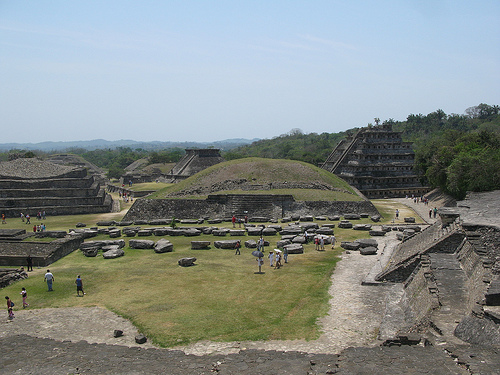

Location: 12 km (7 mi) Southeast of Pozarica, Veracruz Map
Open: 9am- 5pm daily

El Tajin Archaeological Site is an archaeological site situated 12 km (7 mi) Southeast of Pozarica in the Mexican state of Veracruz. El Tajin Archaeological Site reached the peak of its power between early 9th to the early 13th century. The most famous structure of El Tajin is the Pyramid of the Niches. Its unique architecture and appearance makes it one of the most beautiful and notable such structures in Mesoamerica. The 10 km square site is located near the small cities of Poza Rica and Papantla, located on the Atlantic coast of Mexico, directly east of Mexico City. There is a direct road and the site can be reached by car or by frequent buses.
There is a small charge for entering the grounds. Voladores performances are free but it's always good to aid the performers with a donation.
The construction of
ceremonial buildings of the Tajín probably began in the first
century. In the Early Mesoamerican Classic Period the Tajín showed
influence of Teotihuacan as can be seen in urbanism, architecture,
painting, sculpture and ceramics. While in the Postclassic it showed
Toltec influence. El Tajín was the largest city on the northern
coast of the Gulf of Mexico and dominated the territory limited by
the basins of the Tecolutla and Cazones rivers, between 650 and 950
AD The rulers of this capital extended their hegemony from the
Somontano of the Sierra Madre Eastern to the coastal plains of the
Gulf, in the current states of Puebla and Veracruz.
Decadence
of Tajín
El Tajín prospered until the early years of the 13th
century, when it was destroyed by fire, presumably started by an
invading force believed to be the Chichimecs. The Totonacs
established the nearby settlement of Papantla after the fall of El
Tajín. El Tajín was left to the jungle and remained covered and
silent for over 500 years. The site was completely depopulated when the Spanish
conquerors arrived in the sixteenth century, so it was not destroyed
and its existence remained a secret for a couple of centuries. While
the city had been completely covered by jungle from its demise until
the 19th century, it is unlikely that knowledge of the place was
completely lost to the native peoples. Archeological evidence shows
that a village existed here at the time the Spanish arrived and the
area has always been considered sacred by the Totonacs. However,
there are no records by any Europeans about the place prior to the
late 18th century.
Archaeological explorations
In 1785 the engineer Diego Ruiz
visited the site and made a description of this site when he made an
inspection looking for illegal tobacco fields.5 In the 19th century
the site was visited by Guillermo Dupaix, Alexander von Humboldt and
Carl Nebel, who published their notes on the site. The first
archaeologists who arrived at the place in the 20th century included
Teobert Maler, Eduard Georg Seler, Francisco del Paso and Troncoso
and Herbert Spinden and Ellen. With the discovery of oil in the area
roads were built from the 1920s until the 1940s. This allowed for
more intensive investigation of the area. In 1935-1938 he was
assigned to Agustín García Vega the cleaning and exploration of the
area. The first building that was completely free of vegetation of
the jungle was the Pyramid of the Niches. The first archaeological
research excavation was made by José García Payón from 1943 to 1963.
The Mexican Institute of Anthropology and History (INAH) did a site
restoration from 1989 to 1992.
World Heritage Site
This
pre-Columbian city was given the title of World Heritage Site,
considering it an exceptional testimony to the greatness of the
pre-Columbian cultures of Mexico and an outstanding example of its
architecture. On December 14, 1992, the pre-Hispanic site of El
Tajín, located in the northern region of the state of Veracruz, was
inscribed as a Cultural Property on the Unesco World Heritage List.